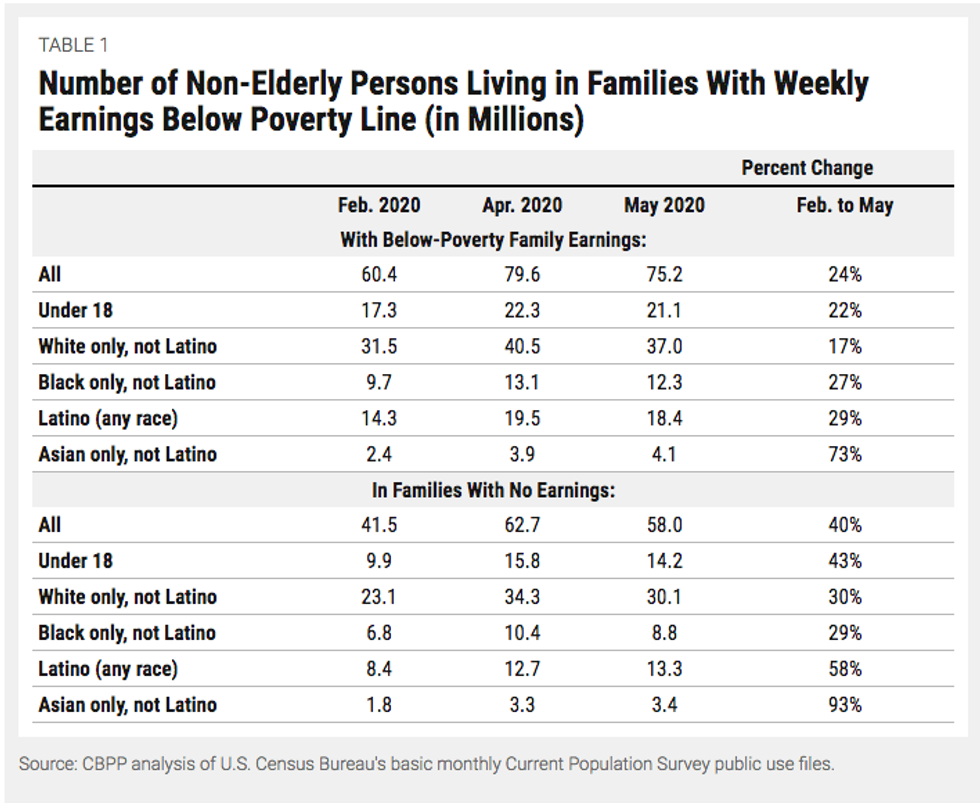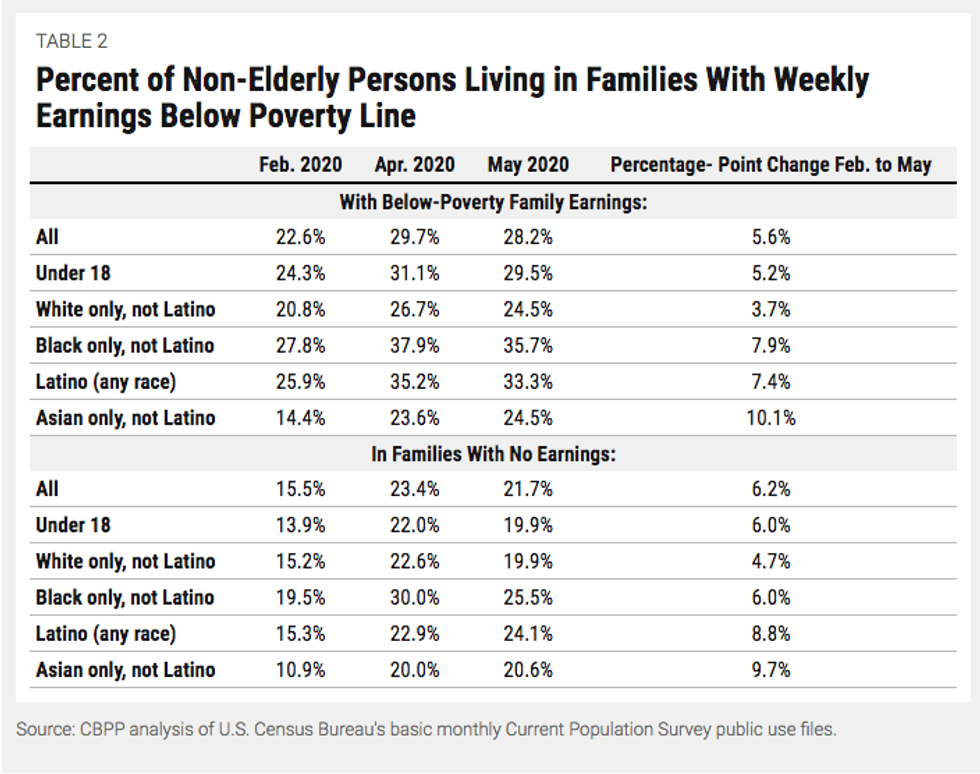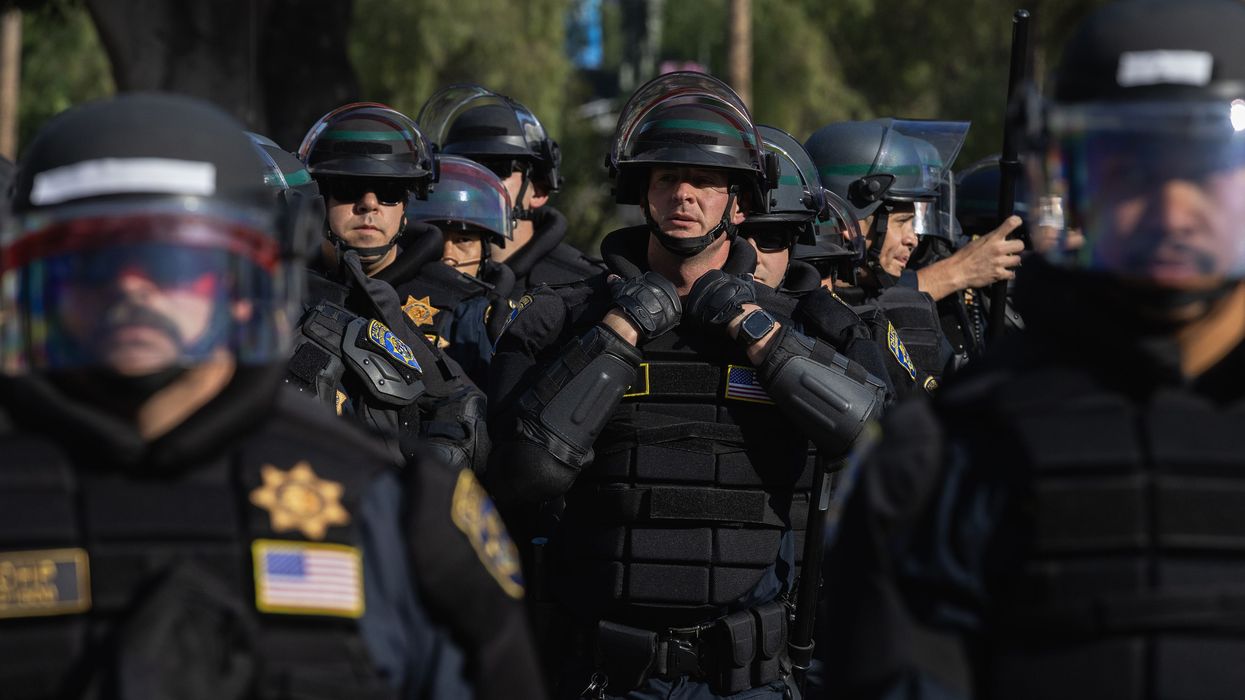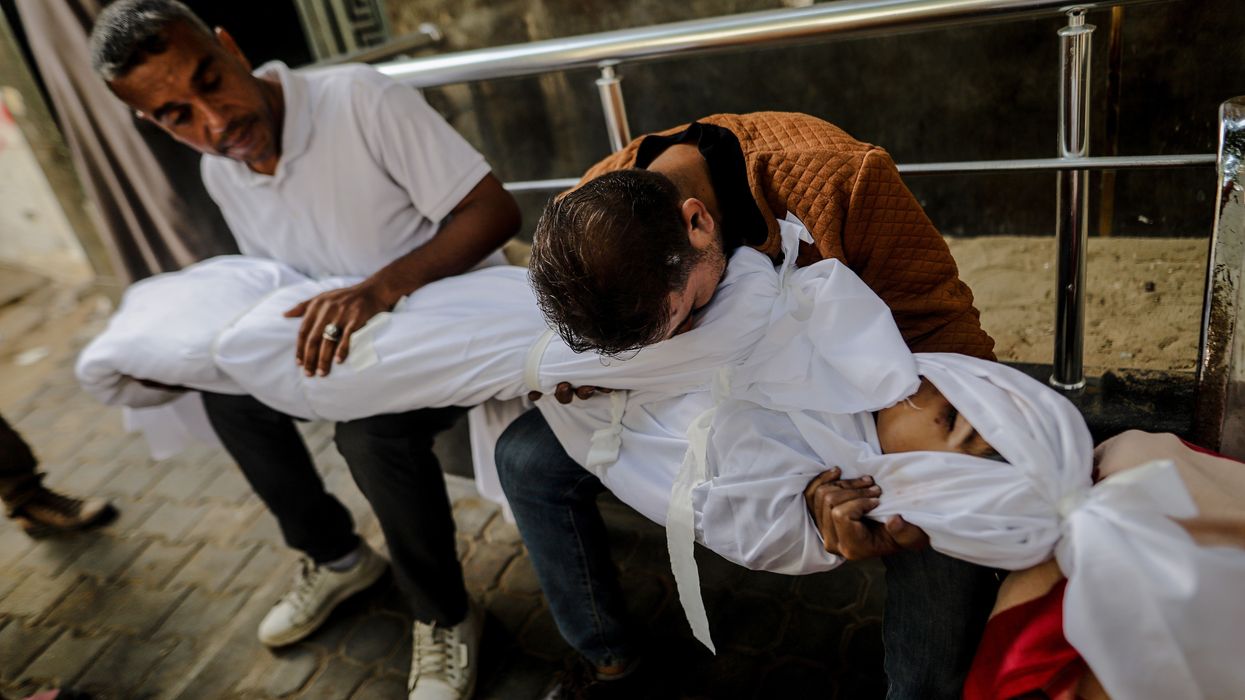June, 16 2020, 12:00am EDT
For Immediate Release
Contact:
Michelle Bazie,202-408-1080,bazie@cbpp.org
Research Note: Number of People in Families With Below-Poverty Earnings Has Soared, Especially Among Black and Latino Individuals
About 75 million non-elderly individuals lived in families with combined weekly earnings below the poverty line in May, CBPP analysis of new Census Bureau data shows -- far above the pre-pandemic (February) level of roughly 60 million, though below the April figure of about 80 million. (See Figure 1 and Table 1.)
WASHINGTON
About 75 million non-elderly individuals lived in families with combined weekly earnings below the poverty line in May, CBPP analysis of new Census Bureau data shows -- far above the pre-pandemic (February) level of roughly 60 million, though below the April figure of about 80 million. (See Figure 1 and Table 1.)
The Bureau of Labor Statistics' official monthly statistics on the record losses in jobs and wages show the pandemic's devastating impact on workers as individuals. But they don't directly show what this means for families' ability to make ends meet. Our new analysis shows the extent to which families have lost earning power and may now need government help in order to meet basic needs. Government assistance is likely keeping many families' total income (including government benefits such as unemployment assistance) above the poverty line.
From February to May 2020:
- The number of non-elderly individuals living in families with combined weekly earnings below the poverty line rose by 14.7 million (24 percent), from 60.4 million to 75.2 million.
- The number of non-elderly individuals with no family earnings rose even more: by 16.5 million (40 percent), from 41.5 million to 58.0 million.
- Among non-elderly Black and Latino individuals, the number with below-poverty family earnings rose by 2.7 million (27 percent) and 4.1 million (29 percent), respectively. Among non-elderly, non-Latino whites, the increase was 5.5 million (17 percent).
- The number of children in families with below-poverty earnings rose by 3.8 million (22 percent), from 17.3 million to 21.1 million.
Between May 2019 and May 2020, the number of non-elderly individuals with below-poverty family earnings rose by close to 13 million.
Many of these families are now receiving help from relief measures, including expanded unemployment and SNAP benefits. But the relief measures enacted to date, including those boosting unemployment benefits and expanding eligibility, are slated to expire in coming months, while the Congressional Budget Office and others project that unemployment will remain high through 2021.
Our analysis also shows that the current recession has hit people of color the hardest. (See Figure 2 and Table 2.) Of special note, Black and Latino workers not only are overrepresented in some of the most-affected industries, but were already at a disadvantage when the recession started due to the nation's long history of inequitable policies and practices in employment, education, and housing. All racial and ethnic groups have experienced sharp earnings losses, but the share of the non-elderly population living with below-poverty earnings started higher and rose more for Black and Latino individualsthan for white individuals. From February to May 2020, the share of non-elderly individuals living with below-poverty family earnings:
- Rose by 7.9 percentage points among Black individuals, from 27.8 percent to 35.7 percent;
- Rose by 7.4 percentage points among Latino individuals, from 25.9 percent to 33.3 percent;
- Rose by 3.7 percentage points among non-Latino white individuals, from 20.8 percent to 24.5 percent.
Among non-elderly Asian individuals, the share living in weekly earnings poverty started lower than for non-elderly, non-Latino white individuals but rose more, by 10.1 percentage points from February to May.
Comparing over the last 12 months to avoid any seasonal influence also shows a large increase in poverty for the overall population. Between May 2019 and May 2020, the share of non-elderly individuals with below-poverty family earnings rose by 4.9 percentage points.
Of those with below-poverty earnings prior to the crisis, some had earnings but earned less than the poverty line; others were between jobs and looking for work or were out of work for other reasons, such illness, school, or early retirement.
Methodology
These figures are from our analysis of the outgoing rotation groups (ORG) of the Census Bureau's monthly Current Population Survey (CPS). The ORG, which makes up just under one-fourth of the CPS monthly sample, includes questions about individuals' usual weekly earnings. Using those data, and annual thresholds for the official poverty measure divided by 52 weeks (and adjusted for monthly inflation by the official Consumer Price Index for all urban consumers), we calculated the number of individuals in families with earnings below the weekly poverty line.[1] (We counted a two-adult two-child family poor in February 2020 if its weekly earnings were below $504; the weekly threshold in May was $500.) The May 2020 survey covered earnings in the week beginning May 10.
The estimates are less precise than the Census Bureau's official annual poverty figures, in part because the ORG sample is relatively small (about 12,300 households in February) and participation in the survey declined non-randomly in the pandemic (to about 11,600 in May). The smallest group shown here -- non-elderly Asian individuals -- is based on a sample size of 513 households in the May 2020 survey.[2]


The Center on Budget and Policy Priorities is one of the nation's premier policy organizations working at the federal and state levels on fiscal policy and public programs that affect low- and moderate-income families and individuals.
LATEST NEWS
A Secretive Program Has Let Cops Spend Hundreds of Millions on Weapons of War, Report Shows
“Our tax dollars are being weaponized against us,” said the head of the Center for International Policy.
Oct 31, 2025
State and local governments have spent hundreds of millions of taxpayer dollars helping cops wage “war” against their own residents under a secretive and opaque program that allows the police to purchase discounted military-style equipment from the federal government.
Over the past three decades, the obscure 1122 Program has let states and cities equip local cops with everything from armored vehicles to military grade rifles to video surveillance tech, according to a report published Thursday by Women for Weapons Trade Transparency, part of the Center for International Policy.
Using open records requests, which were necessary due to the lack of any standardized auditing or record-keeping system for the program, the group obtained over $126 million worth of purchasing data across 13 states, four cities, and two counties since the program's creation in 1994. Based on these figures, they projected the total spending across all 50 states was likely in the "upper hundreds of millions of dollars."
“The 1122 Program diverts public money from essential community needs and public goods into military-style equipment for local police,” said Rosie Khan, the co-founder of Women for Weapons Trade Transparency. “The $126.87 million spent on militarized police equipment and surveillance technology could have instead provided housing support for 10,000+ people for a year, supplied 43 million school meals, or repaired roads and bridges in dozens of communities.”
Congress created the 1122 Program at the height of the War on Drugs, authorizing it under the 1994 National Defense Authorization Act to provide police departments with equipment to carry out counter-drug operations. It was not the first program of its kind, but followed in the footsteps of the more widely known 1033 Program, which has funneled over $7 billion of excess military equipment to police departments.
But there are a few critical differences: 1033 is subject to rigorous federal record-keeping, while 1122 has no such requirement. And unlike 1033, which transfers equipment that was already purchased but not needed, 1122 allows states and cities to spend money to purchase new equipment.
The program's scope ballooned dramatically in 2009 after another NDAA added "homeland security" and "emergency response" missions to its purview. As the report explains, "no regulatory mechanisms are ensuring that equipment is used for counter-drug, homeland security, or emergency response purposes. In fact, the scope of these missions was never defined."
Increasingly, it has been used to provide police with equipment that has often been deployed against protesters, including $6.2 million for weapons, weapons training, and riot gear. Among the equipment purchased in this category was pepper spray, batons, gas masks, and riot shields.
By far, the largest expenditures under the program have been the more than $85 million spent on various armored trucks, vans, and sedans.
Police departments have spent an additional $6 million to purchase at least 16 Lenco BearCats, which cost around $300,000 apiece. These were among the military vehicles used by police to suppress the racial justice protests following the murder of George Floyd by Minneapolis police in 2020.
As recently as October 3, 2025, Immigration and Customs Enforcement (ICE) officers were documented aboard a Bearcat in full military garb and menacing protesters with sniper rifles outside the notorious immigrant detention facility in Broadview, Illinois.
In July, Los Angeles ICE agents were filmed using a vehicle to run over multiple protesters who attempted to block their path.
Another $9.6 million was spent on surveillance equipment, including license plate readers, video and audio recording devices, and subscriptions to spying software that uses sophisticated facial recognition and social media monitoring technology to track people's movements and associations.
The report highlights the increasing use of this technology by college police departments, like Northern Virginia Community College, which spent over $2.7 million on surveillance tech through 1122. College police departments have used this sort of technology to go after student protesters and activists, especially amid last year's nationwide explosion of pro-Palestine demonstrations across campuses.
At Yale, which has made "surveillance cameras, drones, and social media tracking... standard tools in the police department's arsenal," one student was apprehended last year and charged with a felony for removing an American flag from its pole using the school's surveillance system.
The report's authors call for Congress to sunset the 1122 Program and direct its funding toward "a version of public safety that prioritizes care, accountability, and community well-being rather than militarized force."
“Lawmakers, including federal and state legislators and city council representatives," it says, "must act with the urgency that this moment requires to prevent a catastrophically violent takeover of civil society by police, federal agents, and corporations profiting from exponentially increasing surveillance, criminalization, and brute force.”
They note the increasing urgency to end the program under President Donald Trump, who—on the first day of his second term—reversed an executive order from former President Joe Biden that restricted the sale of some of the most aggressive weaponry to local police forces.
“Local police have been given more avenues to arm themselves with military-style equipment during an era of heightened arrests, forced removals, and crackdowns on free speech. These disturbing political shifts have undermined the crucial work of coalitions for police accountability," the report says.
Nancy Okail, president and CEO of the Center for International Policy said: "Our tax dollars are being weaponized against us under the guise of ‘domestic terrorism.'”
"As talk of a ‘war from within’ grows louder," she says, the new report "exposes how this rhetoric fuels real assaults on democracy and civil rights.”
Keep ReadingShow Less
‘Scarier Than Halloween Costumes’: Trump Policies Blamed for Jacking Up Candy Prices
"From the grocery aisles to the doctor’s office, Trump’s economic circus keeps jacking up costs and squeezing household budgets."
Oct 31, 2025
President Donald Trump's economic policies have put a damper on this year's Halloween festivities, as his tariffs on imported chocolate in particular have helped jack up the price of candy.
CNBC reported on Friday that data from research firm Circana and the US Bureau of Labor Statistics show that chocolate prices in the US have jumped by 30% over the last year since Trump began slapping hefty tariffs on foreign goods, including staple products such as cocoa, coffee, and bananas that cannot be grown at sufficient scale in the US.
The increased cost of chocolate has now been passed on to consumers in the form of higher candy prices, according to a joint study released this week by The Century Foundation and Groundwork Collaborative.
According to the organizations' analysis, candy prices as a whole have gone up by just under 11% over the last year, which is more than triple the current overall rate of inflation.
Unsurprisingly, the analysis showed that these increases were particularly severe in candies that had significant chocolate inputs, as it found that "variety packs from Hershey’s (maker of KitKats, Twizzlers, Reeses, and Heath bars) are up 22%, while variety packs from Mars (maker of Milky Way, M&Ms, Three Musketeers, and Skittles) are up 12%."
The analysis also cited recent quotes from the CEOs of retail giants Target and Walmart indicating the president's tariffs were having a major impact on US consumers. Target CEO Brian Cornell, for instance, said on a recent earnings call that the tariffs had created a "challenging and highly uncertain" environment, while Walmart CEO Doug McMillon said that "costs increase each week" thanks to Trump's trade wars.
Sen. Elizabeth Warren (D-Mass.) used the organizations' study to rip the president for raising the price of Halloween candy in a video posted on social media.
"Do you remember when Donald Trump told American families to cut back on buying kids' dolls?" she asked, in reference to Trump earlier this year suggesting parents buy fewer toys for their children after his tariffs on imports raised their costs. "Well now he's making candy more expensive too, just in time for Halloween."
Donald Trump's jacked up candy prices — just in time for Halloween. pic.twitter.com/f3glomQbUK
— Elizabeth Warren (@SenWarren) October 31, 2025
The American Federation of Teachers, whose members have likely experienced the increased cost candy first hand, also took a shot at Trump's economic policies while posting a graph illustrating The Century Foundation and Groundwork Collaborative's study.
"The only thing scarier than Halloween costumes? The rising price of candy from Trump's tariffs," the union wrote on X.
Alex Jacquez, chief of policy and advocacy at Groundwork Collaborative, said that the increase in Halloween candy prices was just one source of pressure facing US families as a result of Trump's economic policies.
In particular, Jacquez pointed to the cuts to the Supplemental Nutritional Assistance Program (SNAP) and Medicaid in the Republican Party's One Big Beautiful Bill Act, as well as the GOP's inaction on extending tax credits for buying health insurance, as major pain points.
"While inflation eats through paychecks and House Republicans hide in plain sight, working families are slammed by soaring healthcare premiums, frozen food assistance, and rising bills," he said. "From the grocery aisles to the doctor’s office, Trump’s economic circus keeps jacking up costs and squeezing household budgets."
Keep ReadingShow Less
Classified US Report Finds 'Many Hundreds' of Alleged Israeli Human Rights Violations in Gaza
The long backlog and a reporting protocol developed especially for Israel are likely to keep Israeli forces from being held accountable, said officials.
Oct 31, 2025
Progressive lawmakers and rights groups have long warned that by arming the Israel Defense Forces and providing the IDF with more than $21 billion, the US has violated its own laws barring the government from sending military aid to countries accused of human rights abuses and of blocking humanitarian relief.
On Thursday, a classified report by the US State Department detailed for the first time the federal government's own acknowledgment of the scale of alleged human rights abuses that the IDF has committed in Gaza since it began bombarding the exclave in October 2023.
The Office of the Inspector General's document, reported on by the Washington Post, which spoke to US officials about it, also detailed how allegations of human rights abuses against the Israeli military are made harder to prove by a vetting process that is only afforded to Israel—not other countries accused of violations.
The US officials said the long backlog of "many hundreds" of possible violations of the Leahy Laws, which bar US military assistance from going to units credibly accused of human rights abuses, would likely take years to review—calling into question whether the IDF will ever be held accountable for them.
"The lesson here is that if you commit genocide and war crimes, do as much as possible because then it becomes difficult to investigate everything," said journalist and Northwestern University professor Marc Owen Jones grimly in response to the Post's report.
The government report was described by the Post days after the State Department dismantled a website used to report human rights violations by foreign militaries that receive US aid, which was established in 2022 to ensure the US was in compliance with the Leahy Laws.
The Biden administration flagged at least two 2024 attacks by Israeli forces—one that killed seven World Central Kitchen aid workers and one known as the "flour massacre," in which more than 100 Palestinians were killed and nearly 800 were injured as they tried to get flour from aid trucks—as ones that may have used US weapons, signaling that continuing US aid to Israel would break the Leahy Laws.
“To date, the US has not withheld any assistance to any Israeli unit despite clear evidence."
A report by Amnesty International last year focused on several IDF attacks on civilian infrastructure—which killed nearly 100 people including 42 children—in which Israel used bombs and other weapons made by US companies such as Boeing.But just a week after the Amnesty analysis, the Biden administration told Congress in a mandated report that it was "not able to reach definitive conclusions" on whether Israel had used US-supplied weapons in attacks such as the one on the World Central Kitchen workers.
After the report of the new analysis, said University of Maryland professor Shibley Telhami, former President Joe Biden and former Secretary of State Antony Blinken "cannot hide from responsibility" after they persistently defended and funded Israel's attacks on Gaza.
But along with the long backlog of potential human rights abuses, the so-called Israel Leahy Vetting Forum, which dates back to 2020, is likely to prevent the State Department from reviewing the allegations against the IDF.
The government's protocol for reviewing allegations against Israel differs from that of other countries; a US working group is required to “come to a consensus on whether a gross violation of human rights has occurred," with representatives of the US Embassy in Jerusalem among those who participate in the working group.
“To date, the US has not withheld any assistance to any Israeli unit despite clear evidence,” Josh Paul, a former State Department official who resigned in the early weeks of Israel's war on Gaza over the Biden administration's military support, told the Post.
Shahed Ghoreishi, a former State Department communications official who was fired earlier this year after pushing for the agency to condemn ethnic cleansing and other abuses in Gaza, said it was "predictable" that the State Department declined to answer questions from the Post about the inspector general's report.
"There may be nothing that can excuse the brushing of crimes under the rug," said Ghoreishi, "but ducking questions and hoping it goes away (including no more State Department press briefings) is an abdication of responsibility to the American people."
The inspector general's report was compiled days before Israel and Hamas reached a ceasefire agreement earlier this month; the deal is still formally in place, but Israel has continued carrying out strikes, killing more than 800 Palestinians since it was signed.
Keep ReadingShow Less
Most Popular



